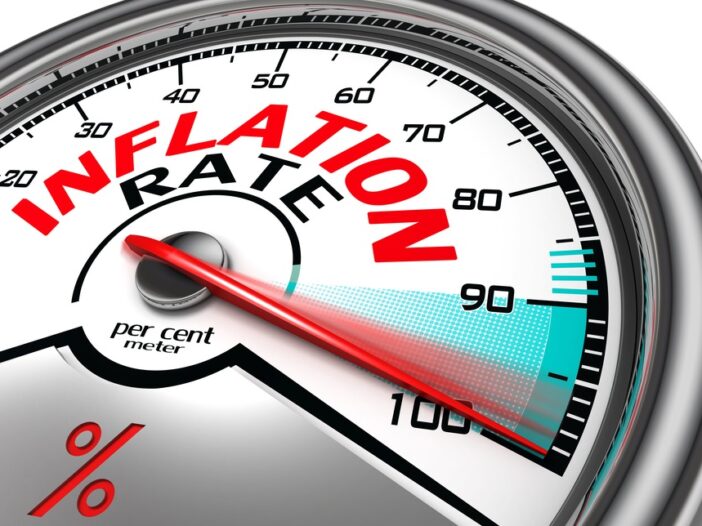In 1976, the Austrian free market economist Friedrich A Hayek made a visit to Australia. He’d been invited by a group of people, some of whom I know personally today. During this trip, he went to the Atherton Tablelands in North Queensland to see one of his host’s cattle farming properties.
Ron Kitching — the Mont Pelerin Society member, Aussie mining industry legend, and cattle farmer — later recalled the visit like this:
‘[Hayek] noticed hanging on the wall of the bar, a large picture of a magnificent Brahman Bull I owned. He asked about the Bull, so I told him he was a prize winning show bull which I had nicknamed Inflation as he would not stop growing. “He weighs 3,000 pounds in his working clothes,” I told the small gathering present.
‘“Well, while I am here, I would like to meet him,” Hayek exclaimed. So I put that on the agenda.
‘I got this bright idea that I’d put the bull in the yard, get a step ladder put Hayek on the bull, (if he agreed), and take a picture which would carry the caption Hayek’s on Top Of Inflation. I told my wife and that was the end of it. She would not under any circumstances countenance such a move. “What if the Professor fell off and was injured?” So that project was abandoned.
‘Nevertheless Hayek still wanted to meet the bull. Next day I took him down the paddock and took several pictures of him and the bull when another idea popped into my head and I quietly mentioned it to him. He was delighted to have a bit of fun. The caption of course was to be Hayek’s Got Inflation By The Balls.
‘Well the old boy was delighted. He was quite at home with animals and had palled up with the bull, which was an easy matter with this particular animal. So he posed and I took the picture. He predicted that if the Americans got hold of a copy, the picture would become famous.’
This photo became so famous that, years later, none other than Margaret Thatcher was presented with a copy of it. The photo shows her economic adviser and intellectual hero grabbing Inflation by the balls, literally. Apparently she liked it. I’m not sure what Inflation thought of it, but he looks nonplussed.
|
|
|
Source: Ron Kitching |
With help from Hayek’s economic theories, Federal Reserve Chairman Paul Volker’s persistence, and Margaret Thatcher’s balls, inflation was eventually brought under control in the UK and US. And it has stayed that way ever since, with more fear about deflation and the bear market it threatens.
Aussie Property Expert’s Bold Prediction for 2026. Discover More.
Until the last few months, that is…
Suddenly, inflation fears are back. As are soaring inflation statistics.
The thing is, just as Australia helped inspire the fight to grab inflation by the balls in 1976, we’re leading the way once more. Unfortunately, not in a good way this time…
A few months ago, the Reserve Bank of Australia ceased pursuing the policy which I believe is the key to unlocking our financial futures. Specifically, they had pegged three-year government bonds at 0.1% yield.
I know that doesn’t exactly sound life-changing. But it is. And it will be again when the policy goes global.
You see, we’re in for an age of what’s called financial repression. When inflation runs hot, but government bond yields don’t go up much.
In fact, it has already begun in the US. Inflation is above 5%, but even the 30-year US treasury bond yield is below 2%. Investors are losing money on loans to the government. A lot of money.
Why would they do so?
Monetary historian Russell Napier argues that this is the wrong question to ask. The right question is why the US government would do so.
You see, just as investors lose out by inflation above bond yields, the government gains. The government’s debt is being paid back by inflation. A few trillion dollars is easy to repay when the value of money is…flexible.
But for the government to get away with the inflation scam, interest rates must not be allowed to spike, even as inflation takes off. Otherwise, the government’s gains on inflation will be offset by higher costs of borrowing. Not to mention the financial crisis which would occur from us borrowers who can’t just print money having to pay more.
The bid to keep a lid on interest rates while engineering inflation is the key to financial repression. It’s all about stealing from investors, slowly, by devaluing their savings.
Thus, under financial repression, central bankers keep bond markets rigged by preventing yields from rising. As the RBA did when it pinned yields to 0.1%. And hence the continued vast Quantitative Easing measures we’ve seen around the world, despite the inflation breakout. Central banks already own vast chunks of their sovereign bond markets. By now they control the market and thereby interest rates.
Here’s how Russell Napier recently explained all this to the Swiss website The Market:
‘The most important part of my forecast is not the inflation rate per se. It’s that interest rates will not be allowed to reflect that rate of inflation. That is what changes the entire structure of finance. This is the key question: Will interest rates, short and long, be allowed to reflect 4% inflation? My answer is No. This is because we will be entering a period of financial repression, where governments keep interest rates below the rate of inflation, just like after World War II.’
Of course, it’s not just the government that benefits from interest rates below inflation. Because the government isn’t the only borrower in the economy. The problem is that it’s the savers who get left holding the bag of devalued money:
‘For the average guy in the street, financial repression can look quite good. Let’s say your wage is going up at 5%, and your mortgage rate is 3%. This is not a bad world to be in at all, arguably for the majority of the population even if their wages only grow in line with inflation. The person who pays the price for this is the saver. Even if you just took the period from 1945 to 1957, which was the period where everybody was doing quite well, you lost 35% of your savings if you held British sovereign bonds.’
That explains the housing boom nicely too, doesn’t it? Everyone is keen to be a borrower when inflation is above interest rates. It’s free money.
But for those of us trying to save, accumulate, and preserve wealth, this is a nightmare scenario. It turns the foundations of investing into quicksand.
It’s not all bad news though.
The financial repression of the ‘40s and ‘50s happened in an age when it was difficult to escape with your savings. If you wanted to participate in the monetary and banking system, which sounds depressing but it was a necessity, you had to play by their rules.
In an age of financial repression, it gives everyday people a means of escape. And that has changed the economic policy game fundamentally. If you participate in it, that is…
Regards,
 |
Nickolai Hubble,
Editor, The Daily Reckoning Australia Weekend
PS: Australia’s Great COVID Recession — Learn which investments to accumulate and which ones to avoid in order to give you the best chance of preserving your wealth during the recession. Click here to learn more.


